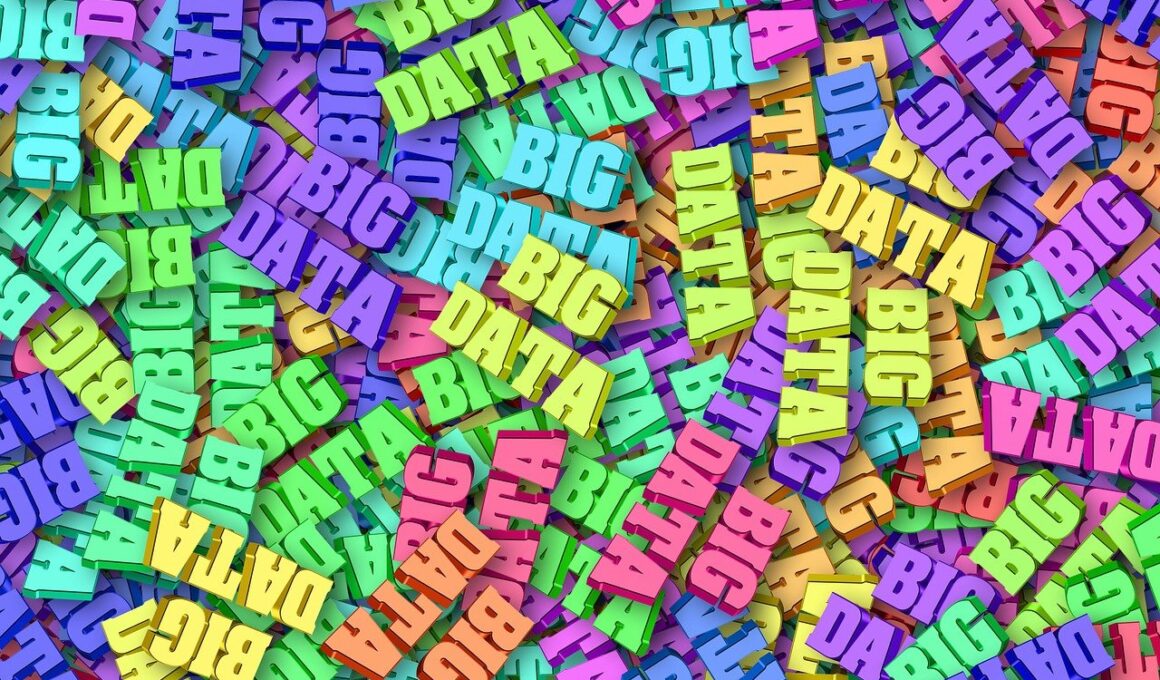Analyzing Workout Data: Turning Numbers into Results
In the realm of fitness technology, data analytics plays a pivotal role in optimizing workout performance. Fitness enthusiasts and athletes alike can leverage data insights to tailor their training regimens effectively. With devices like heart rate monitors, fitness trackers, and smartwatches, gathering workout data has never been easier. Analyzing this data enables participants to track their progress, identify weaknesses, and enhance their overall fitness levels. Advanced analytics applications utilize algorithms to interpret complex data sets, translating raw numbers into actionable insights. This transformation is crucial for achieving fitness goals, whether one is aiming for weight loss, muscle gain, or improved endurance. Fitness data analytics goes beyond simple tracking; it provides a comprehensive overview of performance metrics, allowing individuals to make informed decisions. Users can set realistic goals based on their historical data, thus increasing their motivation to stay engaged. The more personalized the insights, the better the chances of adhering to workout commitments. Innovative applications are becoming indispensable tools in the modern fitness landscape, promoting continuous improvement in various training aspects.
To maximize the benefits of fitness data analytics, understanding the essential metrics is key. Common metrics include heart rate, calories burned, distance, speed, and time spent exercising. By focusing on these indicators, individuals can monitor their physical responses during workouts, adjusting intensity as needed for optimal results. Heart rate is particularly vital, providing insights into cardiovascular performance and recovery rates. When coupled with specific training zones, users can train more effectively, ensuring workouts align with their fitness objectives. For example, maintaining a target heart rate zone can enhance fat burning or improve endurance. Furthermore, tracking calorie expenditure helps users gauge their energy balance, an important factor for weight management. Fitness trackers often feature storing and sharing functions, making it easy to compare metrics with friends, fostering healthy competition and accountability. Users can establish benchmarks based on historical data, pushing them to break personal records. Coaches and trainers also benefit from analytics, as they can better understand their clients’ needs through precise data, leading to more tailored fitness plans. Ultimately, familiarity with these fundamental metrics empowers individuals to track progress toward achieving their fitness goals.
Utilizing Data Visualization Tools
Data visualization tools can significantly enhance the effectiveness of fitness analytics by simplifying complex data interpretations. These tools graphically represent information, making trends and patterns more accessible for users. Visual representations, such as charts and graphs, allow fitness participants to quickly assess their progress, compare data points over time, and identify instances of improvement or decline. For instance, users can observe their performance trends in the form of line or bar graphs, visually illustrating their gains or setbacks. Such clarity fosters engagement, as users may feel a sense of accomplishment when witnessing their progress visually change over time. Pie charts can also be effective in displaying the ratio of time spent in various activities, enabling users to reorganize their routines to balance cardio and strength work effectively. Many fitness applications now incorporate gamification elements through visual cues and challenges, motivating users to strive for continuous improvement. Additionally, social sharing options enhance user experience by allowing friends to view each other’s progress visually. This friendly rivalry not only encourages adherence to fitness goals but also cultivates a vibrant community of fitness enthusiasts committed to shared success.
Moreover, wearable technology has advanced tremendously in recent years, providing users with immediate access to their fitness data. Devices like smartwatches and fitness bands now offer real-time feedback, helping individuals adjust their efforts as they exercise. This immediate feedback loop can be crucial during workouts, as it enables participants to ensure they remain within their desired heart rate zones, maximizing workout efficiency. Furthermore, most devices now feature companion applications that collect data and present it in user-friendly formats. Syncing wearables with smartphones allows for seamless monitoring, providing insights on sleep patterns, recovery times, and even nutritional intake when augmented with meal tracking features. Additionally, some devices employ artificial intelligence to personalize training plans based on collected data, helping users avoid plateaus. These enhancements ensure users stay motivated and focused on attaining their fitness goals. However, it’s essential to understand that while technology can offer guidance, the user’s commitment and consistency remain vital to achieving optimal results. Thus, integrating fitness data analytics into one’s regime marks a significant stride toward enhancing overall health and wellness.
The Role of Machine Learning in Fitness Analytics
As fitness technology continues to evolve, machine learning plays an increasingly prominent role in data analytics. This cutting-edge technology aids fitness companies in assessing enormous amounts of data to draw informed predictions about future performance. Machine learning algorithms help identify patterns within user data that may otherwise go unnoticed, allowing for personalized fitness recommendations tailored specifically to each individual’s needs. This level of customization improves adherence to fitness programs, as users feel their journey is unique and suited to their capabilities. Predictive analytics can also suggest optimal workout times, recovery periods, and training intensities based on historical performance data. Consequently, individuals can receive real-time adjustments to their training plans, propelling them closer to achieving their goals while minimizing risk of injury. Moreover, machine learning-based applications often integrate social aspects, connecting users with similar fitness interests, promoting community motivation. These connections can lead to accountability, as friends cheer each other on and share personal experiences. Leveraging machine learning opens doors for endless opportunities in fitness analytics, enhancing user experience while ensuring they achieve transformative results through informed training decisions.
To ensure the effectiveness of fitness data analysis, it is essential for users to establish clear goals before diving into their training. Clear goal-setting provides a framework that allows individuals to gauge the success of their workout efforts over time. SMART criteria, which stands for Specific, Measurable, Achievable, Relevant, and Time-bound, can facilitate creating achievable objectives. By adhering to these guidelines, users can develop personalized training strategies that complement their fitness levels and aspirations. Moreover, goal-oriented workout regimens encourage individuals to stay engaged and motivated, thus leading to more consistent training. Users may find it helpful to reassess goals periodically, adjusting as necessary to account for shifting interests or fitness levels. Such adjustments can renew motivation and energy when maintaining fitness standards. Fitness analytics tools offer features to set and track goals within applications, enhancing overall user experience. By reflecting on past performance and quantifying progress, users can appreciate how far they have come, reinforcing their commitment to a healthier lifestyle. Ultimately, a clear focus on individual objectives is invaluable for successfully navigating the journey of fitness through data analysis.
Future Trends in Fitness Data Analytics
Looking ahead, fitness data analytics are poised to evolve significantly, with new technologies and methodologies altering the landscape. With the growing use of AI, we can expect enhanced personalization in workout planning and tracking. As technology becomes increasingly sophisticated, analytics tools will likely provide even deeper insights into user data, offering tailored recommendations based on real-time physiological feedback. This evolution could lead to even more immersive training experiences that adapt instantaneously to individual performance levels. Additionally, the integration of augmented reality will likely revolutionize how users interact with fitness data, creating interactive environments that draw users into their training sessions. Moreover, with advancements in wearable technology, devices will become more intuitive, monitoring an expanded range of health metrics, such as hydration levels and stress markers. These innovations can provide a more holistic view of fitness, emphasizing the importance of recovery, nutrition, and mental well-being in achieving fitness objectives. The future of fitness data analytics will redefine how individuals approach their workouts, transforming raw numbers into meaningful insights that inspire change and foster healthier lifestyles.
In conclusion, fitness data analytics represents a crucial aspect of modern fitness technology, turning raw workout numbers into actionable insights. Through the integration of advanced analytics, data visualization tools, and personalization from machine learning, users can optimize their training strategies effectively. Emphasizing clear goal-setting ensures individuals stay focused and motivated throughout their fitness journey. The technology available today empowers users to track their progress with real-time feedback, celebrating improvements while addressing setbacks. As innovations continue reshaping fitness analytics, emphasizing community and connection will enhance motivation, further transforming individual experiences. In an ever-evolving fitness landscape, leveraging data analytics optimizes personal training efforts and fosters a culture of health and wellness. By embracing these technological advancements, users can transform their training habits to reach their fitness objectives confidently. Ultimately, the future of fitness data analytics promises exciting possibilities for health enthusiasts to access the resources they need to achieve transformative results and sustain healthier lifestyles well into the future.


